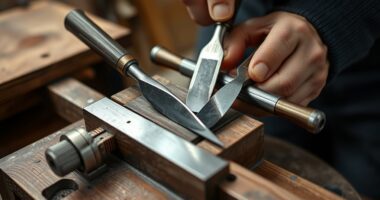Performing a 30-second blade balance test helps you quickly detect vibrations that could disrupt turning operations. Securely mount the blade on a balancing fixture and spin it at operating speed. During the test, observe for any wobbling or excessive shaking, which indicates imbalance. If vibrations are minimal, your blade is well-balanced; if not, further adjustments are needed. Keep in mind, understanding the nuances of this test can improve your turnover and reduce machine downtime—explore more to enhance your technique.
Key Takeaways
- Securely mount the blade and spin it at operational speed to observe vibration levels during the test.
- A smooth, wobble-free rotation indicates the blade is balanced; excessive shaking suggests imbalance.
- Conduct the test quickly, typically within 30 seconds, for an efficient assessment of blade vibration status.
- Minimal vibration during the test confirms the blade’s readiness, reducing risk of uneven wear and noise.
- If imbalance is detected, perform rebalancing procedures to ensure vibration-free turning and optimal machine performance.

Have you ever wondered how to determine if a blade is perfectly balanced? Ensuring proper balance is vital to prevent vibrations that can compromise your machine’s performance and longevity. The 30‑second blade balance test offers a quick, effective method to assess this without the need for complex equipment. To start, you’ll want to perform a thorough blade inspection, checking for any visible damage, dents, or deformations that could affect the balance. Once you’ve confirmed the blade’s physical integrity, you can proceed with the vibration analysis, which is the core of this simple test.
Begin by mounting the blade securely on a rotating fixture or spindle designed for balancing checks. Turn on the machine and let the blade spin freely. As it reaches operating speed, observe the vibration levels carefully. If the blade is perfectly balanced, you’ll notice minimal vibration, and the blade will spin smoothly without wobbling or excessive shaking. If there’s noticeable vibration, it indicates an imbalance that needs correction. This quick visual and tactile assessment is often enough to identify whether the blade requires further balancing adjustments.
The beauty of this 30-second test lies in its ability to quickly reveal imbalance issues through vibration analysis. Excessive vibration during the test suggests that the mass distribution along the blade isn’t even, which could lead to uneven wear, noise, and mechanical failure over time. If you detect vibrations, it’s essential to perform a more detailed blade inspection to locate the imbalance source—whether it’s debris, corrosion, or uneven material removal—and then rebalance the blade accordingly. Regularly performing this rapid check can save you time and prevent costly repairs by catching issues early. Additionally, understanding blade balance can help maintain optimal machine performance and reduce the risk of damage caused by vibration.
Frequently Asked Questions
How Often Should the Blade Balance Test Be Performed?
You should perform blade maintenance and vibration monitoring regularly to guarantee safe operation. For the 30-Second Blade Balance Test, it’s best to do it at least once a month or whenever you notice increased vibrations or irregularities. Consistent testing helps identify imbalances early, reducing equipment wear and preventing failures. Incorporate this test into your routine maintenance schedule to keep blades balanced and vibration levels under control, ensuring peak performance and safety.
What Are Common Causes of Blade Imbalance?
Blade imbalance often results from blade wear or material inconsistency. When blades wear unevenly, it creates weight differences, causing imbalance. Material inconsistencies during manufacturing can also lead to uneven weight distribution, resulting in vibrations. Regular inspection helps catch these issues early. You should check for blade wear signs and guarantee materials meet quality standards to prevent imbalance and maintain ideal turning performance.
Can the Test Detect Internal Blade Defects?
Think of your blade as a finely tuned instrument; its harmony depends on more than surface appearances. This test mainly detects external imbalances, so it’s not a reliable tool for internal flaw detection. While it excels at defect identification related to weight distribution, it can’t reveal hidden internal flaws. For thorough internal defect detection, you’d need specialized methods like ultrasonic testing or X-ray inspection.
Is Special Training Required to Perform the Test?
You don’t need special training to perform this test, but understanding blade adjustment and vibration analysis is helpful. By observing the blade’s balance during the 30-second test, you can identify potential vibration issues. Familiarity with these concepts allows you to interpret results more accurately, ensuring you maintain ideal blade performance. With some basic knowledge, you can effectively use the test to monitor and improve vibration-free turning.
How Does Blade Imbalance Affect Machine Lifespan?
Think blade imbalance is no big deal? Think again. It quietly rots your machine lifespan, turning smooth operation into chaos. Every wobble and uneven weight stresses components, causing premature wear and tear. So, while it might seem harmless, blade imbalance secretly shortens your machine’s lifespan, leading to costly repairs. Ignoring it now could mean replacing your equipment sooner than you’d like—so stay vigilant and keep those blades balanced.
Conclusion
Just as a tightrope walker maintains perfect balance to cross safely, your blade’s stability guarantees smooth, vibration-free turning. The 30-second blade balance test acts as your safety net, catching small imbalances before they cause big issues. By regularly checking your blade’s balance, you keep the machinery humming like a well-orchestrated symphony. Remember, in the dance of precision, even a moment’s imbalance can throw everything off—so stay vigilant and keep your blades perfectly balanced.









